An art critique as well as exhibition preview and overview archive spanning from 1999 to 2012 by Mary Lee Pappas, the art critic for the alternative weekly newspaper, NUVO, and visual arts columnist for the daily paper, The Indianapolis Star. Indianapolis, Indiana.
Ad
Wednesday, June 11, 2003
Art of Architects - Woodburn and Westcott - June 11, 2003 - 4 stars
This exhibition, conjured up by gallery owner and curator Doris V. Hails, makes good sense. Local architects make our immediate environments beautiful places to live and work. Architectural design is public and visually engages community in the arts. It’s utilitarian, its our heritage, it is art and deserving of being given a gallery venue. Artwork in the stylistically diverse show ranges from books and nudes, to annoying nonsense machinery. Kipp Normand’s architectural reliquaries, which, he says, “Are all about dead buildings,” sentimentally preserve the stories of notable demolished Indianapolis buildings. History and neighborhoods tend to die, too, when buildings are lost, but tearing down culture to create culture was once the irresponsible Indianapolis way. Original black and white images or the represented buildings lay next to their boxes. Fractured pieces of wood and the unlikeliest of salvaged bits contained in his pieces successfully and sincerely demonstrate the fragile balance and importance of these places better than the Indiana State Museum’s entire School 5 façade “save” which screams of guilt. Through July 26; 317-916-6062. – Mary Lee Pappas
Wednesday, June 04, 2003
One Earth Festival - Garfield Park - June 4, 2003- 1 1/2 stars
May 31-June 1. This event in our city’s oldest park didn’t effectively accomplish its goal of celebrating unity and diversity among different cultures and religions. Isn’t that what the Italian Street Festival at Holyd Roasary Church, the Eiteljorg’s Indian market, the Middle Eastern Festival at St. George Orthodox Church, Fiesta and the International Festival, among others, already do more successfully? Just how the booth selling pewter figurines of wizards and the like meshed with the mission of the event is definitely questionable. If cultural diversity is a key theme, then a diversity of world cultures should be represented beyond hippie clothes and hemp bags. Our city has a history of great cultural diversity that is underestimated and rich with authentic resources that could have been called upon to participate in theis idealized exercise. Booths were not marked and there was no schedule of events to be found. – Mary Lee Pappas
Art Fair at the 54th and Monon Shops - 54th and the Monon - June 4, 2003 - 2 stars
May 31. Admission, popcorn and hotdogs were free at this one-day event. It was less art fair and evidently more promotional tool for the stores inhabiting that block of 54th Street. There was plenty of parking and booths were easy to maneuver through. Located smack-dab off the Monon Trail, biking or walking to this fair was made easy. The caliber of art ranged from very good (Happy Trails, Douglas David and many others) to questionably less-than-average. The crisp, white-tented booths were sturdy and wind resistant, but there was no signage to adequately identify the participating artists. While some booths were set up professionally with art objects carefully displayed, others were uninspired with wares thoughtlessly strewn on foldout tables. A great idea at a great location, setting an aesthetic standard is needed for what could become a nice tradition. – Mary Lee Pappas
"Shaky Hands" - The Enchanted Studio - June 4, 2003 - 3 1/2 stars
The interior of artists Mary Jo DeMyer’s Enchanted Studio, featuring a colorful array of bold outsider art, feels like what could be the feminine side of the Rev. Howard Finster. Glitter-encrusted doll-sized wire beds and chairs are suspended from the ceiling of this playground barn along the Monon Trail at 54th Street. An aged pink piñata, really big papel picado Las Posadas banners and a porch swing add to the folkish flavor. The cartoonish incongruence of the playfully painted walls and floors, along with the cotton quilted tab curtains, warrant the enchantment title. Five other outsider artists’ work can be found here. Kansas City artist Allann Winkler’s soda cracker box big-headed people, round and bright eyed, aren’t too far a cry from Laylah Ali, who recently exhibited at the MOMA and Indianapolis Museum of Art. The comic book inspiration forms, rounded eyes, heads and mouths are all similar though possibly less ambiguous. So, who’s to say that outside art is really so outside? Through June 14; 317-753-1004. – Mary Lee Pappas
Tuesday, June 03, 2003
"An Eye Blink for an Eye Blink" David Kadlec closes his Eye Blink Gallery, Published June 3, 2003 in NUVO

By Mary Lee Pappas
Published in NUVO June 3, 2003
David Kadlec closed his gallery, Eye Blink, after the exhibit of Sam Sartorious’ paintings, Up All Night, came down at the end of last month. Kadlec opened the space after the Faris Building, where he had a studio for 11 years, was sold to Lilly.
“When I left the Faris I had the chance to get this specific space. The gallery came of this place,” Kadlec explains of his Murphy Building gallery.
“I could show my work and other people’s work. It was such a spontaneous thing. It wasn’t like I was always thinking, jeez, I should have a gallery.
“Everything seemed to point to it in that moment.”
Ending Eye Blink is, in essence, an eye blink, too. “Naming Eye Blink was not the end of it. It happens all the time in life. This is absolutely a continuation of that process of paying very deep attention to what it is that excites me and what I need to do,” Kadlec said of closing the gallery to take the next step in his life.
“What I’ve known for some time is that I needed to devote my time to fighting for the planet, for clean air, clean water and for a sustainable relationship between humans and the planet. I’ve had this sense for a long time. This is part of my call to action for myself. I don’t even know what that’s going to look like for me.”
Initially, it means spending time at his family’s cabin in central Minnesota, the state where he grew up. “I want to spend some time up there and watch the spring and summer unfold a bit, go swimming every day, make some new art and think about life. And those are things you can do all at the same time!” Kadlec explains, “I feel this delicious sort of openness about all of it. I trust it all. My job is to keep my heart open and my eyes open and respond to what I’m feeling inside.”
Coming back to Indianapolis isn’t out of the equation either.
“I’m proud of this place,” Kadlec said about Eye Blink. “It’s been a great effort and a lot of fun. To elevate my own work and get it in front of people is the coolest thing I’ve ever done. The whole thing has been about love. Now I think there is something cooler for me to do.”
He’s elevated Todd Lantz, Matt Davey and Terry Steadman along the way, too, and received great joy from their art. “They are doing astounding work. Communicating so, so beautifully and so clearly.”
Unforgettably poetic and lyrical shows of outstanding quality (Kyle Blevins, Doug Travis and Karen Thompson particularly) have been some of Kadlec’s gifts to our arts community.
Painter Keith J. Hampton will be doing something cool of his own when he debuts his new gallery, It’s All Art, in the old Eye Blink space during the next Murphy Building open house June 6.
Wednesday, May 21, 2003
Master class, Jim Sholly makes art of art books - May 21, 2003
The designer just disappears! I’m sure I got credit somewhere in here,” Jim Anders Sholly says as he flips through Crossroads of American Sculpture, a book he designed for the Indianapolis Museum of Art’s retrospective exhibition of the same name in 2000. “It’s in four-point type,” he says, studying the forward pages and talking about how happy he was to be included in the project.
Principal designer and co-founder of the graphic design company Antenna, Sholly recently completed another book design project, The Herron Chronicle, The First One-Hundred Years, for the Herron School of Art’s centennial. It’s been a fitting project as Sholly earned his BFA in design from Herron in 1987 and has been an adjunct visual communications faculty member there.
“I became involved in the book project through Marty Krause,” Sholly explains. Krause, an editor and one of three authors for the Herron book, has been the curator of prints, drawings and photographs at the IMA since 1979.
Garo Andresian: Written in Stone, a catalogue of prints by Andresian, published by the IMA in 1995, “Was my first book with the IMA. Laura and I did it. It was so nice of them to take a chance on us because we had no real book experience. It was exciting ... a learning process.”
Laura Lacy-Sholly, Sholly’s late wife, was also his Antenna design partner. “We were this happy unit, functioning perfectly and then suddenly everything was different,” Sholly says. “It’s sort of hard to explain how that really was. Time is very strange. Sometimes it seems just moments ago and other times it feels a lot longer than that.”
Having met while attending Herron, the Shollys married in 1991. Laura passed away in June of 1999. A scholarship in her name was created at Herron.
Learning to work alone was very difficult. “Totally. Absolutely. Over the years we had worked out our routine,” Sholly recalls. “It wasn’t a conscious decision, but we each ended up taking on different aspects of projects and everything just sort of worked out. I’ve tried to maintain the same ideals and standards.”
The couple founded Antenna in their Broad Ripple townhouse apartment. “Laura and I were students together. We had the business before we were married. I think we always knew that it would happen, that we would be in business some day, but it really came together in 1990.”
While working for a small design studio, Design Ogden, they were offered rental space to do their own design work. Instead, they set up shop at home. “We actually had a typography instructor who was really influential,” Sholly says, referring to former Herron professor Candace Lorimer, who ran her clothing design business out of her apartment in the same complex. “We saw that it could be done that way.” Lorimer, who prints her designs for interior furnishings for her New York shop, employed the Shollys for projects. “We just had a couple of clients and it grew through word of mouth. It was this natural, intuitive progression. We didn’t know anything and we didn’t have anything to lose,” Sholly says.
Being a confident young couple had its benefits. “I think it was very appealing to clients. It showed a certain stability or something. We thought even though we’re independent, we’re small, we’re in Indianapolis, we could still do work that was still really going to be world-class. It was going to be very different, very thoughtful, and interesting.” Sholly starts to laugh and says, “We were really pretty full of ourselves thinking that we could do all of that, but that was the idea anyway.”
A match was made with artist Paul Harris early on. “We did work for an exhibit of Paul’s called One Night Stand.”
The Shollys were students in a silkscreen class Harris taught at Herron. “You could see them migrate toward each other,” Harris says of the Shollys’ initial attraction. “I can’t say enough about Jim. He is a grand, grand person.” Harris, who also received a BFA from Herron, requested that they create a souvenir book for his show. “Jim and Laura came up with all of it. They assembled them on the dining room table. Jim understands artists better than other graphic artists.” This project turned out to be the foot-in-the-door predecessor of future art book projects.
Annually, from 1992 to 2001, Sholly designs were chosen for the American Center for Design’s 100 Show of Excellence, an internationally juried review of graphic design. In 1996 Antenna work was also selected for Mixing Messages: Graphic Design in Contemporary Culture, a major graphic design survey at the Cooper-Hewitt, Smithsonian National Design Museum, which led to multiple works by the Shollys being acquired by the Smithsonian,
“There aren’t many museums that are strictly devoted to design,” Sholly explains. “The inherent nature of graphic design is transient. It is typically meant to be used and then discarded. Some museums will have a small graphic design collection,” Sholly adds, “but it’s rare to have a museum dedicated to preserving it.
“I don’t know that graphic design is highly valued here, or something that most people are even interested in or even care about,” Sholly says of design in Indianapolis.
From production to print, Sholly was involved in every process of the casebound Herron book. “They didn’t impose any restrictions and gave me freedom to create.”
The half coffee table, half history book has a distinguishable Antenna look and feel. It’s physically and aesthetically soft. Even dark browns feel cool and elegant with the Antenna treatment of four-color imagery printed on uncoated paper. “It flattens it. It makes it a little more tactile,” Sholly says of how the technical process enhances the visual elements.
The Herron Chronicle is an Indianapolis art history book and a work of art unto itself, created by one of Herron’s best. Printed were 2,500 copies and they are available for sale at Barnes & Noble and through Herron’s faculty office, building HM, room 109. Copies are $40. Call 317-920-2455 for more information.
Principal designer and co-founder of the graphic design company Antenna, Sholly recently completed another book design project, The Herron Chronicle, The First One-Hundred Years, for the Herron School of Art’s centennial. It’s been a fitting project as Sholly earned his BFA in design from Herron in 1987 and has been an adjunct visual communications faculty member there.
“I became involved in the book project through Marty Krause,” Sholly explains. Krause, an editor and one of three authors for the Herron book, has been the curator of prints, drawings and photographs at the IMA since 1979.
Garo Andresian: Written in Stone, a catalogue of prints by Andresian, published by the IMA in 1995, “Was my first book with the IMA. Laura and I did it. It was so nice of them to take a chance on us because we had no real book experience. It was exciting ... a learning process.”
Laura Lacy-Sholly, Sholly’s late wife, was also his Antenna design partner. “We were this happy unit, functioning perfectly and then suddenly everything was different,” Sholly says. “It’s sort of hard to explain how that really was. Time is very strange. Sometimes it seems just moments ago and other times it feels a lot longer than that.”
Having met while attending Herron, the Shollys married in 1991. Laura passed away in June of 1999. A scholarship in her name was created at Herron.
Learning to work alone was very difficult. “Totally. Absolutely. Over the years we had worked out our routine,” Sholly recalls. “It wasn’t a conscious decision, but we each ended up taking on different aspects of projects and everything just sort of worked out. I’ve tried to maintain the same ideals and standards.”
The couple founded Antenna in their Broad Ripple townhouse apartment. “Laura and I were students together. We had the business before we were married. I think we always knew that it would happen, that we would be in business some day, but it really came together in 1990.”
While working for a small design studio, Design Ogden, they were offered rental space to do their own design work. Instead, they set up shop at home. “We actually had a typography instructor who was really influential,” Sholly says, referring to former Herron professor Candace Lorimer, who ran her clothing design business out of her apartment in the same complex. “We saw that it could be done that way.” Lorimer, who prints her designs for interior furnishings for her New York shop, employed the Shollys for projects. “We just had a couple of clients and it grew through word of mouth. It was this natural, intuitive progression. We didn’t know anything and we didn’t have anything to lose,” Sholly says.
Being a confident young couple had its benefits. “I think it was very appealing to clients. It showed a certain stability or something. We thought even though we’re independent, we’re small, we’re in Indianapolis, we could still do work that was still really going to be world-class. It was going to be very different, very thoughtful, and interesting.” Sholly starts to laugh and says, “We were really pretty full of ourselves thinking that we could do all of that, but that was the idea anyway.”
A match was made with artist Paul Harris early on. “We did work for an exhibit of Paul’s called One Night Stand.”
The Shollys were students in a silkscreen class Harris taught at Herron. “You could see them migrate toward each other,” Harris says of the Shollys’ initial attraction. “I can’t say enough about Jim. He is a grand, grand person.” Harris, who also received a BFA from Herron, requested that they create a souvenir book for his show. “Jim and Laura came up with all of it. They assembled them on the dining room table. Jim understands artists better than other graphic artists.” This project turned out to be the foot-in-the-door predecessor of future art book projects.
Annually, from 1992 to 2001, Sholly designs were chosen for the American Center for Design’s 100 Show of Excellence, an internationally juried review of graphic design. In 1996 Antenna work was also selected for Mixing Messages: Graphic Design in Contemporary Culture, a major graphic design survey at the Cooper-Hewitt, Smithsonian National Design Museum, which led to multiple works by the Shollys being acquired by the Smithsonian,
“There aren’t many museums that are strictly devoted to design,” Sholly explains. “The inherent nature of graphic design is transient. It is typically meant to be used and then discarded. Some museums will have a small graphic design collection,” Sholly adds, “but it’s rare to have a museum dedicated to preserving it.
“I don’t know that graphic design is highly valued here, or something that most people are even interested in or even care about,” Sholly says of design in Indianapolis.
From production to print, Sholly was involved in every process of the casebound Herron book. “They didn’t impose any restrictions and gave me freedom to create.”
The half coffee table, half history book has a distinguishable Antenna look and feel. It’s physically and aesthetically soft. Even dark browns feel cool and elegant with the Antenna treatment of four-color imagery printed on uncoated paper. “It flattens it. It makes it a little more tactile,” Sholly says of how the technical process enhances the visual elements.
The Herron Chronicle is an Indianapolis art history book and a work of art unto itself, created by one of Herron’s best. Printed were 2,500 copies and they are available for sale at Barnes & Noble and through Herron’s faculty office, building HM, room 109. Copies are $40. Call 317-920-2455 for more information.
Wednesday, May 14, 2003
33rd Annual Broad Ripple Art Fair 4 - Indianapolis Art Center - May 14, 2003 - 4 stars
May 10-11. The not-great weather only demonstrated how well the Indianapolis Art Center is organized and accommodating to attendees and artists under the weirdest of weather conditions. The BRAF turned out to be like a boot camp for artists, complete with thunderstorms, tornado warnings, high winds and cold weather dipping 10-15 degrees below what local forecasters promised. After dodging threatening green skies Saturday, there were a few ideal hours of sunshine and kettle corn aroma wafting through the air. It was so cold on Sunday that the Starbucks booth ran out of coffee. One exhibitor said that if an artist could make it through the weekend, then every art fair after would be a piece of cake. Optimism prevailed through this test of endurance as tents flew and ceramics crashed. Mud pits and rising White River water forced some artists to move to higher ground after the deluge of Saturday morning. A few left altogether. There was a State Fair aroma in the air from the straw salvaging the grounds. The hard-core and generous volunteers who braved it all defitiely earned the art fair wings and will be remembered (Betty, you rock!) for their tour of duty. Kudos to the staff for all their hard work, which is an understatement. Attendance for this fund-raiser was evidently low but that turned out to be of great benefit for the serious shoppers. To their advantage, lines were short and booths were easy to maneuver through. I spoke to several artists who were pleased with their sales while others were taking things in stride. If you stayed home, consider renewing your IAC membership soon. – Mary Lee Pappas
Wednesday, May 07, 2003
Second Annual Artful Tread - Mass. Ave. Arts District - May 7, 2003 - 3 1/2 stars
May 2-3. This fun public display of artfully rethought old tired mixes local commerce with art more successfully than the 500 Festival’s cars to celebrate the 500 Festival. The creative diversity was evidently greater. Participating Mass. Ave. businesses displayed their tire art either in their shop windows or on sidewalks. Just as Chicago’s “Cows on parade” in 1999 brought life-size cow sculptures to the Loop, these real and thus life-sized tires engage the whole community directly with art through a little humor and wit. Urban Bloom’s suspended hangman treatment of a tire within a tire and old sign letters spelling out “ART” along the bottom perimeter was a great assemblage piece in and of itself. The flower planter outside of Jungclaus Campbell with a tire serving as a base was sweet and delightful. Jenny Elkin’s tire at her gallery was transformed into a cartoonish fish by having been painted orange, given fins and one big boggle eye. More obvious and equally silly was the minimalist approach to the project taken by 4 Star Gallery. Propped up in their front windows sat “Really Old Tire,” which was simply a really old tire cracked, worn and unadorned. Yat’s doused their peach-painted tire in glitter (it looked like a Homer Simpson-worthy fantasy iced donut) and Scholar’s Inn turned theirs into a huge Disneyland martini topped off with a cherry. Two days just isn’t enough time for the city to enjoy this. Perhaps next year the 500 Festival will exploit and put their funds toward enhancing this successful grass-roots art endeavor. There was no red tape on these tires. – Mary Lee Pappas
Wednesday, April 30, 2003
Plein Air Paintings from New Harmony - Hoosier Salon - April 30, 2003 - 3 stars
This group shows the broad range of style presented by these artists. Highly representational works in true-to-life colors are expected and found on the uncluttered gallery walls, making the diversity ever apparent. "Yellow Tavern" by Dave Kercheval, a lively New Harmony street scene played out in cotton candy pink, tweety bird yellow and glitter, is a primo example. It's great and works to create the illusion of reality in the same way the more traditional colorists do. Illusion is further achieved with incongruence of perspective to the buildings depicted and serves as another element that made this work stand out. Thomas Robinson's "Spring Hillside" is another standout with its purples and vigorous yet careful paint handling. The framing and presentation is always superb at the Hoosier Salon. Through May 7, 2003; 317-253-5340. - Mary Lee Pappas
"Facts and Fictions" - Domont Studio Gallery - April 30, 2003 - 3 1/2 stars

Facts and Fictions: Harry and Lois Davis
Harry and Lois Davis, married for 55 years, exhibit their stylistically different works together with wonderful and not surprising success.
Lois tastefully tackles social issues in her imaginative, figurative works with lilaclike pastel hues. "Traditions: After a Holiday," a diptych of pre-Christmas sale shopping and post-Christmas returns, shows a funny, but all too true scene of folks relatively void of holiday spirit rushing anxiously to buy now just to take it unsentimentally back. "The Children Die: Winter Enters Our Hearts" is powerfully sad as parents bury their children in the foreground, while havoc plays out behind.
Harry's paintings of buildings familiar to any Indianapolis denizen are amazing. There is no painter locally who is technically comparable or as eloquent. Using acrylic on masonite, paint is thinly and deftly dappled in careful (more like accomplished) layers, creating a beautiful illusion of reality. The texture is super smooth, opaque and tactile, so much so that you can't tell the works on canvas from those on masonite. You can see every brick in the painting of "Coulter Flats," located at 2100 Meridian. The orange-red roof catches noonday sun and contrasts perfectly with the teal sky. Through June 7, 2003; (317) 685-9634
NUVO Newsweekly, April 30 - May 7, 2003
Page 27
Mary Lee Pappas
Wednesday, April 23, 2003
John Bragg, Stephen Hartley, J.D. Nolan - The Photography Gallery - April 23, 2003 - 3 stars
Hartley's negative processing technique requires a flow chart to explain. It's something like developed slide film like regular film, made negative of images, then played in Adobe PhotoShop. Dissection aside, the image result is somewhat rough, punky and clearly unique. Nolan sticks to traditional darkroom processing, an old-fangled formula compared to the new high-tech norm. Ordinary images, like "Sunflower," a straight-on shot of the flower, get color enhanced by oil pencils delicately detailing. Bragg, who shoots professionally for Indy Men's Magazine, is a plain-old great photographer. His candids of Ballet Internationale dancers at rest in the wings hang on the gallery's east wall like a journalistic photo essay. They're damn near perfect. Stripped of glossy stock and sharp graphics, the pure artistry of his work can be seen in these inkjet prints floated on white mats. The grainy quality works in his favor to sculpt out the white-on-white image of Emily Griffen, chef at Tavola di Tosa. Through April 25, 2003; 423-9237. - Mary Lee Pappas
Eclectic Art Sale - Artistik* - April 23, 2003 - 2 stars
One of those two stars is a sympathy star, a designation never before handed out, simply because the venue is brand spankin' new. Though pottery classes, photography, art and picture framing at affordable prices are touted, this venue opened with a whimper. Silver in the City inhabited this space previously and you'll know it because their old signage still traces the bottom border of the windows. This is just one obvious sign of unpreparedness. The art on paper wasn't adhering to the mats they were floating on and were unframed (in a frame shop to boot). Though I was unimpressed with the poor display and presentation of the work, I sincerely wish for them not to go the way of Rocky Mills and Gilda's. The venue has the good fortune of settling into a fine piece of Mass. Ave. arts district real estate, but this address alone is not enough to validate it. Through May 4, 2003; 317-638-0791. - Mary Lee Pappas
*Artistik closed its' doors several months later.
*Artistik closed its' doors several months later.
"Turn On" - LAMP - April 23, 2003 - 3 stars
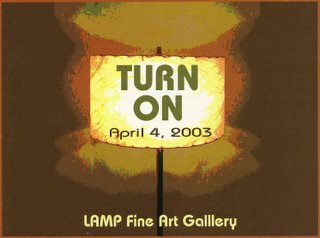
A gallery that started with know-how, talent, sharp survival instincts and not a whole lot else proves that the community wants quality art. This 11-artist group show is another in a series of solid displays of local artists without representation who seek out this professional venue. A lyrical photographic series of a girl and an old window by Herron student Laura Elizabeth Boone was sold-out. The dirty, salvaged window-props cloud the square format images. The girl, sometimes dramatically holding the window, is drenched in beige and nude color though severe light is hitting her. The work is Eyeblink worthy. I can't help but hear a Tom Tom Club song that goes, "With my boyfriend, my lucky boyfriend," every time I see a piece by Greg Seagrave. Multiple layers of bright primary colors zigzag into funky patterns. Mosaics of color with an intricate graffiti feel fuse well and somehow manage to be easy on the eyes. The details make his work more than decorative. The fanciful, not imaginary, landscapes of Ron Stock have a Dr. Seuss whimsy with peter Max colors, only Peter Max can't paint as well. Cheery, Bulbous, lavender trees and orange sidewalks outlined in black are technically refined in execution, making them effectively playful. Through May 31, 2003; 624-9803. - Mary Lee Pappas
Wednesday, April 16, 2003
Shannon Lo "Beauty in Simplicity" - Fountain Square Library - April 16, 2003 - 1 1/2 stars
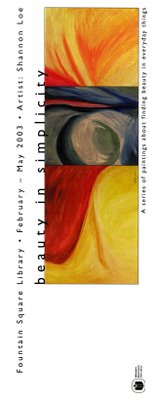
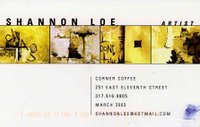
Depth and contrast are missing in these nine simple and dull colored abstract works. Uncomplicated biomorphic swirls and close-up twists are painted timidly. They are an anxious attempt to be something more than whim. This show is a reminder that, ultimately, an artist creates to satisfy oneself and never-ever for review. Putting art out there for the world to see takes guts and has to go hand-in-hand with the desire to elevate that art, to learn from the experience, Objectivity and detachment can be uncomfortable lessons, but improve the purpose for the artwork. A promotional card reads, “A series of paintings about finding beauty in everyday things," which very well could mean finding beauty in the experience of painting. Through April, 2003; 317-269-1877. –Mary Lee Pappas
"Beyond Enron: The Politics of an Aesthetic Revolution in a Post War Economy" - Everyday Inventors - April 16, 2003 - 3 1/2 stars
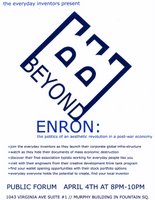
The only gallery to boast a time machine, Everyday Inventors parodies art as big business better than some do professionally through performance, video, photography and funny fake name badges. It's too bad extra curricular cash can't turn their well-defined let's-pretend concepts into reality, but that's part of the parody, too. "Politics are imbedded in this aesthetic revolution,'” the exhibit statement, "Beyond Enron 2003 Conference" pamphlet, states. "Studies have shown that fine art can no longer survive in museums and traditional gallery space." Beyond Enron emphasizes that a gallery is like a corporation based on aesthetics. Smart and well-conceived, El is tastefully raising the local bar for art with modesty. Through June 6, when their next exhibit, Time Travel Experiments, opens; 317-955-7577. -Mary Lee Pappas
Wednesday, April 09, 2003
Sofiya Inger - Borders River Crossing - APril 9, 2003 - 3 1/2 stars
A single 5-foot-by-10-foot painting, “Vanishing Worlds," hangs alone in the quiet coffee shop. There appear to be six scenes of turmoil acted out in fragmented human silhouettes that Inger refers to in her statement as "bullets," "despair" and "ill." Hot yellows and oranges flare like fire against tile deep burgundy cloth they are painted on. Cool contrasting blues and rich greens create depth and visual comfort walling a Russian expressionistic/folk tradition. A soft and curvilinear treatment adds to the melandio~-meets4antasy mood. The contemporary evolution of humanity has taken some decidedly less than humane stumbles. This is a timely piece of art that approaches truth through genuine sentiment. lnger is represented at Woodburn and Westcott where more of her work can be viewed. Through April, 2003; 317-574-1775. –Mary Lee Pappas
Tim Harmon "The Disposable Coffee Caddy Redefined" - Cath Inc. - April 9, 2003 - 3 stars
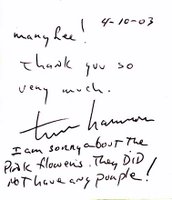
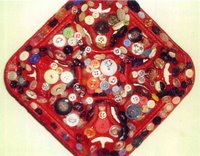
Harmon, of Tim'n'Avi fame, presents 30 good-humored, rethought and recycled four-cup coffee caddys. The pressed composition cardboard trays, strictly utilitarian and immanently disposable, are affectionately appreciated for their purpose and keen design. Silly, impractical and sometimes in left field, this show is not short on giggles or smarts. Caddy #24, "Let It Be" War Scene, features little plastic Army men battling it out on their sand glued caddy under little plastic Iraq and American flags. Crank the music box hidden below and the Beatles' "Let It Be" chimes like a lullaby. It's a sweet message of peace that sucks you in with its playfulness, but doesn't bonk you over the head a la Michael Moore acceptance speech. Caddy #21, nothing more than a cast aluminum caddy made with the assistance of artist Eric Nordgulen, wonderfully emphasizes the design competence of the paper product by timing it into a sculptural piece of an. 'Rainbow Glitter," Caddy #9, with glitter glued all over, is a hoot. Each caddy is more amusing than the last, whether it be "Zen Garden," "Candle," "Jesus on His First Easter" or "Antique Quilt." This stop-and-smell-the-flowers show (take note of everyday design) is a happy offering by someone who loves art and sees artistic potential in all sorts of salvage. Through April, 2003; 317-251-2677. -Mary Lee Pappas
Wednesday, April 02, 2003
Jason A. Miller - Starbucks (3778 Meridian St.) - April 2, 2003 - 3 stars
Two framed landscape photos rest on an easel in the northwest corner of this intergalactic coffee shop. This could be a relatively nice exhibit venue if art could be hung on the west wall and if that particular wall wasn't covered in ugly corporate wallpaper. It would have been great to have seen more work by this photographer. The glossy photo images are slightly blurred, evoking memory and sensory feelings. Colors are cool and few, with black shadows that fuzz out. These very beautifully composed scenes are dreamy and captivating. 317-920-8670. -Mary Lee Pappas
Wednesday, March 26, 2003
William F. Kaeser - Midland Arts and Antiques - March 26, 2003 - 3 stars
Fourteen paintings by Indiana artist Kaeser, from his estate, are currently available for sale by Tom Shipley at Midland. A 1932 Herron graduate, Kaeser is probably best known for his WPA post office mural, "Loggers," in Pendleton, Ind. Having studied with William Forsyth and Clifton Wheeler, the German-born Kaeser painted his share of Indiana landscapes and was as such affiliated with the Hoosier Salon. He exhibited at the New York World's Fair in 1939, much to his credit as well. Modern figurative works were his preference and reflect the crammed, active spaces presented in this group of work. "Topless Tango" has a Good Times feel to it. Its compressed composition of furious topless dancers stacked next to each other has a folky flatness. Most of the pieces, images of Midwestern common man condition, have this mo5aic ambiance. Priced fair for worthy pieces of Indiana art history and worth a look. 317-730-4573. –Mary Lee Pappas
Douglas David "Indiana Peonies" - Midland Arts and Antiques - March 26, 2003 - 3 stars
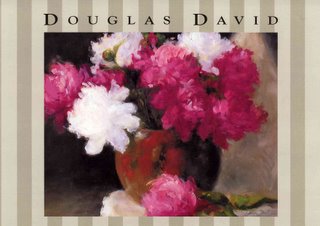
'INDIANA PEONIES': DOUGLAS DAVID 3 stars Midland Arts & Antiques. Blankets of lush, predominantly pink peony oil paintings line the entrance walls at Midland A palette of soft, rich periwinkles and pinks cover the unframed canvases, creating a light and airy atmosphere. Unrestrained wide strokes push these safe and minimal colors into their bushy flower likenesses. Though paint is handled loosely, the romantically pretty work is too safe to be truly expressionistic, The sense of grace and pastel hues recall Rococo, though are nothing Watteau would know. David beautifully composes his still lifes by gently balancing form and tone. The eyes move gently through his pieces. The small crop-shot peony bloom series is abstracted just enough to suggest their bunchy shapes. This could be said of his even smaller peony oil sketches, full of whirlwind energy, that are a bargain at $65 each, two for Sl 00. His landscapes carry lavenders and deep blues experienced at sunset. By default, everyone in Indiana will have a David work of art in 2003 because he designed the new license plate. Through April 27, 2003; 317-267-9005, -Mary Lee Pappas
Wednesday, March 19, 2003
Randall Scott Harden and John Reynolds "Close to Nature" - Hoosier Salon - March 19, 2003 - 3 1/2 stars
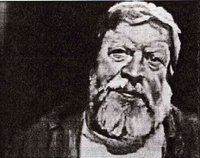
The new and without question improved Hoosier Salon Gallery can boast space, better fighting and easier access to the organization. Traditional Indiana landscapes get a color-tinged twist in the works of Harden and Reynolds. Harden's painterly depictions of Power-laden scenes are executed with thick impasto swabs of color impressionistically dabbling his canvases. His picket fence views are less inspired than the nearly biomorphic oil on paper small landscapes. Smooth and shiny, they are abstracted just enough. "Sunlit Givery," with its purples and pinks against green and hints of blue and hot red on the horizon, are a testament to his well-balanced visual talents. John Reynold's many rooster, cow and nature paintings are executed expressively with a cooler color palette and softer hard. Teals and pea greens shadow and highlight his roosters while contrasting vibrantly against the red-red cock's combs. "Hereford at the Fond" is a comparatively tiny piece at 7-inches-by-5-inches. It's a realistic representation of a cow you'd want to know, with streaks of purple reflecting in the white waters, Both artists are excellent and produce quality in their traditional genre. The Hoosier Salon is a prime, and recommended, spot to view and weigh the transition traditional painting is undergoing in Indiana. Through April 12, 2003; 317-253-5340. –Mary Lee Pappas
Jennifer Bartlett "Prophetic Agenda and the Feminine Mystique" - Jarrett Engineering - March 19, 2003 - 1 1/2 stars
(5335 N. Tacoma Ave.). A federal judge ruled in 2001 that Barbie could be parodied by artists it, their work. Since then, artists have much abused this Mattel medium to explore sexuality, female stereotyping and pop American culture. Barbie exploitation is seen so often that it has become pitifully cliched, particularly in contemporary art photography. Just in time for Lent, Bartlett presents a softly focused, dramatically lit Barbie and Ken enacting stories of the Bible and the Apocrypha in this photo series with titles that include "Eve Defies Adam," "Ester Saves the Jews" and "An Adulteress Repents." You need not be a Bible-thumper to be confused by this show. It's a wee bit overwrought with intended symbolism, among other things, to be just goofy. Local photographer Cy McOuigg, who has done comparable doll imagery, does a much better job. Located in the far corner of a smoky old office (you have to weave between work stations to see it), the work is framed really nicely, complete with brass title plates. Not all atypical art venues work (hair salons, for instance) but the staff was gracious and this office had an eclectic charm. Here is a random smattering of national Barbie art photography to peruse: www.geocities.com/micromarty/ADbarbie.htm; http://helios.acomp.usf.edu/~difrey/. Through March 21, 2003. -Mary Lee Pappas
Wednesday, March 12, 2003
Caroline Mecklin - Deano's Vinos - March 12, 2003 - 4 1/2 stars
Mecklin, known for her nudes and portraits, presents an outstanding new body of work. Her approach to painting is so distinguishable and proficient that it is a delight to see her stretch beyond her already high standard of excellence. Everything is polished. In one piece, a pastel lounging woman is framed by the fabrics she lies on - shapes and dashes of bright color surrounded by black. The spontaneous, patterned image advances toward the viewer and conceptualizes reality and the human form. This odalisque is elegant, beautiful and masterful. Another portrait, in charcoal, is inspired. Mecklin's unending artistic examination is demonstrated well here and worthy of note. An artist reception will take place March 21. Through April 4, 2003. –Mary Lee Pappas
Edie Gray - Joe Reuzar's Deli - March 12, 2003 - 2 stars

While the black beans and rice at Reuzar's were delicious, the art on the walls was bland and state. The collection of naive acrylic abstractions lacked technical substance, yet were still expressive, maybe even personal, in their own psychedelic way. Unfortunately, they carried a generic, replicated look. Only "Soul Dance," with its swirly pastel colors, had a more fluid edge. The manipulated photos on display better expressed the artist's aesthetic sensibilities. While the compositional continuity was maintained, the colors were hotter and the warped forms had depth. The work was enhanced by excellent matting and framing. The photos spoke for themselves. 317-916-DELI. -Mary Lee Pappas
Wednesday, March 05, 2003
Me, Myself and I, Self-Portraits - Indianapolis Museum of Art - March 5, 2003 - 3 stars
The collection of self-portraits, from Durer to Rauschenberg, are sensitively conceived representations of the artists’ personalities and serve as valuable documents of art history. Primarily black and white images (etchings, engravings, lithos and drawings) are crisply presented in plain, bleached wood frames with white mats. Ibis enhances the sketchy and intimate feel of the show. Self-portraits are, as the exhibit explains, "artistic exercise” that every artist utilizes to sharpen skills. Aesthetic sensibilities, status and technique are sharpened through these self-studies. They convey what the artist thinks of herself or, in the case of this grouping, mostly himself. George Cruikshank, who illustrated Grimm's fairy tales and Charles Dickens works, represents himself in the same manner as his famed illustrations. A piece by a promising Indiana artist f the late 19th century, Charles David Fiscus, is displayed. One of only two works completed by this artist before his death at the age of 22, it is delicately and masterfully rendered, especially when compared to fellow Herron student Glen Cooper Henshaw’s pompous pose. This is a show (the Goya and Mora pieces are very cool) that artists and students of art history should see and savor. Let's hope this gallery doesn't experience the abnormally high levels of humidity plaguing the Turner Gallery next to it during this wet weather. A renovated facility with more than a mere hygrothermograph can't come soon enough. Through March 9, 2003; 317-923-1331. -Mary Lee Pappas
Wednesday, February 26, 2003
Full Circle: James Willie Faust - Domont Studio Gallery - Feb. 26, 2003

Full circle: James Willie Faust
Visual Arts Review | Thru March 22
Mary Lee Pappas
*Pictured: "Auspicious Night" by James Wille Faust
John Domont speaks articulately and poetically for the art he represents at his Domont Studio Gallery. His words are coup for gallery hopper James Wille Faust, who has settled at Domont for his first solo show in three years. Simply said, the paintings are more of the same - more rote than ripe. A myriad of highly defined, primary colored, stay-in-the-lines circles and triangles wading or warping in modular forms. They need only a black light to enhance the psychedelic optical illusions.
Distance is best for viewing. Pencil marks peek from around the shapes, serving as reminders that these are created by human hand. The repetitive, mechanical formula within Faust"s compositions appears playful and familiar. Hanging powerfully as a group, it"s apparent that his superior color balance and tonality have become more sophisticated and refined.
Internally, the pieces visually contract - not unlike the works of Op artist Auguste Herbin whose famous 1944 "Air, Fire" painting fundamentally achieves what Faust"s do, but without a final acrylic airbrush layer. This body of work (landscapes and the human being series) is, coincidentally, titled Earth Air Fire Water, in tribute to those elements. One influence on these pure-effect works that command questionably steep prices could be early sales successes.
Faust, actively collected locally, is a favorite big fish in our little pond. But his brilliant sculptural models, intended for monumental public works of art, make his paintings look like sketches. Given the opportunity, Faust"s artistic vision would gloriously come full circle. Geometry within geometry, these 3-D pieces bring his hard-edge imagery to spectacular, inspired life. It would be in the interests of the Indianapolis Art Center and the Indianapolis Museum of Art to include him in their sculpture park plans. Through March 22; 685-9634.
Wednesday, February 12, 2003
Bartosz Pietrzak "Pietrzak Puls" - The Photography Gallery - Feb. 12, 2003 - 4 stars
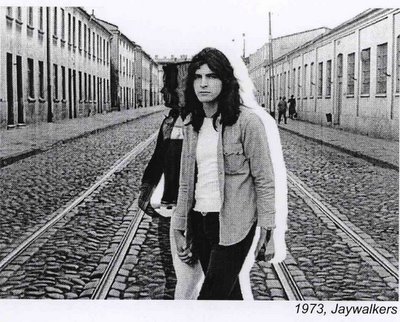
Photographer Bartosz Pietrzak was exiled from Poland in 1982. As a member of the Democratic Opposition Movement, which started in 1976 and became the future inspiration for the national solidarity movement in Poland, Pietrzak was co-editor and photographer for an underground paper, the Puls (Pulse). "You had to do something. It was hopeless," he said of his journalistic efforts. Martial law was imposed on Dec. 13,1981, sending him to prison, but not for long. "They were visibly interested in getting rid of us," he explained of the government. Pietrzak was given a choice in 1982: stay in jail or emigrate to the United States. Grabbing a few personal belongings, including photos, Pietrzak and his wife left Poland. Half of the 20 photos on exhibit at the Photography Gallery are piecemeal examples of his black and white work from the 1970s. Some of these were rescued by friends and sent to him here. These images have been digitally reshot, cleaned up and reprinted, resurrecting them with the same integrity as their original gelatin silver prints. Others have been executed over the last three years. "For 20 years I didn't do anything until three years ago," Pietrzak said. Digital photography was the enabling factor. Most all of the works adhere to a photomontage convention. Viewing the photo fabrications of environments and objects is like reflecting on, or entering, a daydream. Unmodified portrait images from the 1970s are strikingly candid. Pietrzak's explorative montage method is successfully demonstrated in this deserving and splendid show. Though diverse, the images have a poetic uniformity. Pietrzak has exhibited in Germany, Denmark, Malaysia, India, Great Britain, Brazil and now, fortunately, in his Indiana home. Through Feb. 28, 2003; 317-423-9237. –Mary Lee Pappas
2003 National Scholastic Art Awards of Central Indiana, Inc. - Harrison Center ofr the Arts - Feb. 12, 2003 - 3 stars
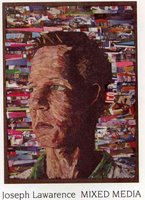
Three hundred terrific artworks selected from over 3,000 submitted by junior, middle and high schools from around Indiana. Eleven professional artists judged and ranked the works as Gold Key (highest award on a regional level), Silver Key (second highest), Honorable Mention and the Best of Show Awards, known as the American Vision Awards. Gold Key and AVA winners' works will go to NYC to be judged for over $1,000,000, in awards and scholarships, then travel to Washington, D.C., for exhibition. Any of the mature Gold Key drawings created in Jonathan Kane's Carmel HS class will give their national competitors a run for their money. His students have quite a competent and comfortable grasp of color and values, Carmel HS and Jefferson HS (Lafayette) are by far the best represented out of the 582 eligible schools. Visual arts magnet Broad Wipp4e HS was represented by a slim picking of six pieces, but happily garnered an AVA and two Gold Keys. Though some of the work isn't completely indicative of students' own freedom of expression, the overall magnitude of talent is great and, even more, inspiring. To say I had a favorite piece in the show just wouldn't be right. But I must admit that as I have painted in my studio, just up the stairs from the HCA Gallery, I've traipsed down to the gallery to specifically visit work by Joseph Chang, Gold Key Fine Arts Portfolio winner from Harrison HS. Through Feb, 23, 2004; 317-514-6787. -Mary Lee Pappas
Wednesday, February 05, 2003
Millet to Matisse - Speed Museum, Louisville, Kentucky - Feb. 5, 2003 - 3 stars
A joy if you love art history, miserable if you need to visit the two-seater lavatory. Millet to Matisse is fantastic but not the blockbuster exhibit touted. Pioneers of 20th century painting, Van Gogh, Monet and Matisse were used as marketing candy to seduce an audience for a brilliant tutorial. This collection from the Kelvingrove Art Gallery in Glasgow, Scotland, is rich with examples by artists who are sometimes overlooked, like Alfred Sisley and Adolphe Hervier. Paintings by Rouault, Corot, Cezanne and even a piece by Utrillo expertly walk you through a revolution in artistic technique and perception. The Speed was not equipped to handle the car traffic, or the pedestrians awaiting entrance into the show, The limited audio tours were sold out and the line for the WC was longer than for the exhib7it. This show travels to the Frick (Pittsburgh) next and is well worth a visit. –Mary Lee Pappas
Katherine Hanley Knutson "Flowers and Animals" - White River Gardens - Feb. 5, 2003 - 2 1/2 stars
Proficient photo-realistic watercolor paintings of polar bears, zebras, elephants, bears and penguins from the Indianapolis Zoo all look beige and blend into the stone wall of the Schaefer Rotunda where they hang. Though beautifully framed by JoAnne ETC, as a group, the adept works suffer from sameness. Images are painted as intended with little overall surface mixing. The comparatively colorful flower paintings were equally skillful though the still lifes looked like funeral arrangements instead of escapist bouquets. Proceeds from sales benefit the Indiana Zoological Society, Knutson's work is also available in the Indianapolis Zoo's gift shop. Through March 9, 2003; 317-630-20O1. -Mary Lee Pappas
Wednesday, January 29, 2003
"Brain: The World Inside Your Head" exhibit review, Indiana State Museum, Published January 29, 2003 in NUVO

BYOB: Bring your own brain
Exhibit Review | Thru May 4, 2003
Mary Lee Pappas
NUVO, Published January 29, 2003
A deep muffled heartbeat seductively draws you into this hands-on exhibit. Your own brain will determine if you enjoy it - if you can stomach the reproduction dog brains. Will your soft, gelatin-textured brain remember the gory skull of Phineas Gage whose head was penetrated by a rod during an 1848 explosion? Will you relinquish any stigmas you may have had about brain-based diseases and disorders after learning that Abraham Lincoln suffered from depression? That Winston Churchill and Vincent Van Gogh had bipolar disorder?
Author, mental health advocate and Walter"s daughter, Kathy Cronkite, spoke at the member"s preview last Friday and said, "Learning disabilities may just be a different way to learn that may not fit in with the school system." Parents with children labeled by their teachers as generically dyslexic or ADD understand this all too well. Our brains make us uniquely who we are. An exhibit display says it best: "Your sense of who you are comes from an interior movie your brain constantly creates. You are the star, screenwriter, camera operator, producer and director. You are the movie studio and the movie theater. Rather, your brain is."
Commendable programming accompanies the exhibit, from a Brainy Brownies badge workshop to a program about stroke risk factors. Engaging for all audiences, from icky to profound, this exhibit was summed up best by Cronkite: "It"s fabulous."
Brain: The World Inside Your Head is on exhibit at the Indiana State Museum through May 4. Call 232-2637 or log on to www.indianamuseum.org for more information on hours and programs.
Milton Flournoy III "Milton's Mirrors of Contemporary Art" - The Cube Restaurant - Jan. 29, 2003 - 1/2 star
With very dim lights and few fast food counters within its front door, the Cube is an unfavorable venue for art. Not only can the potent burrito and pizza smells permeate artwork, grease can coat it. For the mirrors on display this could be doubly disadvantageous when all things airborne hit the thinly applied acrylic paint on the mirror surfaces. Sure, there are Raushenbergs disintegrating in museum storage rooms, but these mirrors hanging immediately above the laminated patron tables seem especially vulnerable to splattering mustard or greasy fingerprints. A boy at a stream, squiggles, an abstracted figure were a few of the maroon-toned (it was hard to discern in the light) doodled and random images on various store-bought mirrors. The Cube does neither these mirrors, not the artist, Milton Flournoy III, any favors. Through Jan. 30; 317-972-1382. -Mary Lee Pappas
Wednesday, January 22, 2003
Group Show - LAMP - Jan. 22, 2003 - 3 1/2 stars
A variety of female artists' work, mostly good, some quite forgettable, hangs very well as a whole for this show. A+ for presentation. Opaque, flat glazed, small ceramic sculptures by Michelle Smith are kind of Monty Python meets Mary Englebright, but not really. The dainty pieces are given serene faces, one with something that looks like a yellow daisy swim cap, surrounded by the likes of periwinkle-stamped butterflies. Easily likable and bearing merit, they are whimsical without the art fair look. Yasha Persson's distinctively manipulated photographs are ripe with symbology, beauty and color, without an outrageous price tag. Stacy Novak's large oils, recently displayed at Vic's Coffee Shop, on the other hand, are a bit too high. Her soft Images, feminine pale pinks and designs she creates around her figures, are attractive and seductive. Her paints are mixed with some disproportion. It's like nails down a chalkboard to see dull spots next to high shine. Nancy Kruse's straight-on views of local church doors were decorative. She has a real sense of light and illusion, but reeds to work on the painting part. “Boxed ln," an installation by Jan Van Flexon and Indianapolis Museum of Art light designer Carol Cody explores confinement socially, culturally and personally. It's no surprise that MTV2 chose to film a spot with MadLab at LAMP last weekend. The LAMP (Local Artists Making Progress) space, a former nursing home facility, is steadily making progress This gallery is in it for the artists in a good-spirited, fundamental way. To get more of a taste, listen to LAMP director, Jennifer Kaye, on NPR's (90.1 FM) Art of the Matter this Saturday, Jan. 25, 4-5 p.m.;. Through Jan, 25; 317-722-0137. -Mary Lee Pappas
All that glitters - Indianapolis Museum of Art - January 22, 2003

* Pictured - An evening suit, designed by Coco Chanel, part of the "All that Glitters" exhibit at the IMA
* A personal aside - My mother was a buyer at L.S. Ayres during her time there from 1947 to 1968. Her expertise and experience have enabled and fed my fashion and fabric brain.
Currently on exhibit at the Indianapolis Museum of Art, All that Glitters consists of 20 primo examples of classic couture women's evening wear from the IMA's collection of over 700 pieces. Spanning the 1950s through the '80s, these glamorous garments are encrusted with hand-applied sequins and beads. They represent an era when dressing up was the norm for an urban evening. Plum colored walls create a sumptuous backdrop for these extraordinary 20th century garments in the third floor gallery dedicated to textiles. Designers represented are Coco Chanel, Guy Laroche, Givenchy, Fontana and Indiana"s own couturier trio Bill Blass, Halston and Norman Norell. Terrific examples of these designers' looks go hand-in-hand with the glitter of their meticulous, hand-embellished ornamentation.
Beautiful examples of Halston's work, the best represented of the group, size up style trends, quality and his distinctive look. Cute on the right person, a Pinto orange tank dress saturated with orange beads and a solid bugle-beaded tie belt from 1980 is a bit on the dramatic side. His bubble look jacket, made from a single piece of fabric, gathered at the shoulders, is masterfully constructed. More typical is a timeless 1980s red, long-sleeved cardigan jacket and pants, beaded in the same red with a unique, swirly pattern on synthetic fabric. It's topped off by a gorgeous double-layered silk chiffon halter top with a wrap-around waist sash. Though Halston's bead work was done in India from 1973 on, these two outfits represent the tedious art of beading by hand, which has mostly been replaced by machine beading.
You only have to think leisure suits to know that the 1970s and '80s weren't an elegant time in fashion history. Dressing up was fizzling out and a dated pink and black diamond patterned Givenchy top from 1985 shows it. This piece has a generic Bill Cosby sweater-trend look as opposed to the revered Hepburn style for which Givenchy is best remembered.
Though simple and tailored, the single Blass piece, a pink and purple painted and studded python jacket, would have required the right wearer to carry it off as elegantly as it was made.
A graceful, late 1950s strapless Givenchy ball gown is more to the point. The salmon pink silk shantung skirt is dreamily exquisite and need only be accompanied by Prince Charming. It's a typically cultivated ball gown of the day with a gathered skirt, fitted and embellished bodice, a little lowered waistband and horsehair reinforced skirt. Today, women don"t have the opportunity to buy dresses like this, let alone have a place to wear them. This dress would have been pricey for the day, though probably not a one-of-a-kind.
Hopefully, only one was made of the over-the-top Fontana early 1950s ball gown of silk velvet trimmed in ermine. It's no wonder that Fontana became known for theatrical clothes, having produced such an outlandish gown. It is more costume than evening attire. In extreme contrast is a Fontana silk lace and organza ball gown from the same period. All kinds of beads - scallops, metal, glass - sprinkle through the four panels of bias cut fabric.
The two Chanel offerings in the exhibit are by far the most timeless and refined. A silver and gold three-piece suit shows Coco Chanel's classic tailoring and unprecedented style. Francois Lesage, who did bead work for couturiers, should get full credit for a green Chanel suit on exhibit. A straight, ankle-length skirt falls below a simple hip-length jacket with a small mandarin collar - both meticulously adorned with green bugle beads. It is a gorgeous masterpiece. Lesage, who worked with all the best designers, took over an embroidery workshop in 1949 that was historically synonymous with luxury, having created for the likes of Napoleon III.
Most all of the beaded pieces displayed are executed on lightweight silk chiffon. Most notable is a sarong style dress by Halston from 1973 with a fish tail back. The silk organza is so heavily ornamented with crowded mirror, glass and other beads, you wonder how the raglan sleeves could hold under their weight. It appears to be remarkably heavy - though hardly a sacrifice for the lucky wearer of this work of art. This exhibit is a real treat, superbly exemplifying clothes as a complex artform. Fashion is an elaborate mix of collaborators, fabrics, designers, colors and trends all coming together - for a party dress. Through May 4; 317-923-1331.
Wednesday, January 15, 2003
Ivy Campbell and Zenobia Weigel - Hot House, Murphy Art Center - Jan. 15, 2003 - 4 stars
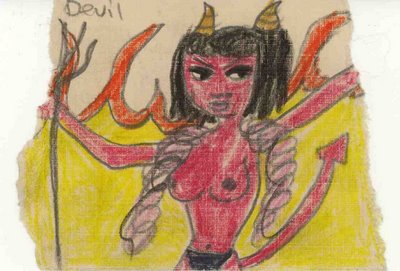
Ten-year-old Ivy is the daughter of artist Phil Campbell and 11-year-old Zenobia the daughter of artist Jo Legner Phil's partner, so it's no wonder that these two young ladies would be artistically ahead of the game for their age. Very imaginative and keenly observant, they've already staged four sold-out showings of their young drawings and paintings, the last of which was at Deano's Vinos. The girls talked about how they were founding their own theater club, having determined that a Shirley Temple styled Little Princess would be their first performance, all the while holding a yellow plastic Hello Kitty mini safe for their drawing sales. The 40 or so nude female drawings, executed in No. 2 and colored pencils, from 8-by-1O's to 2-by-2s, are quite admirable. Artist Lois Templeton purchased two drawings and praised the girls' confidence with portraying the naked female form and doing so with accuracy. They are all proportionately correct, cartoonish with outlines (not sketchy), each unique with individual expressions and Barbie enviable hairstyles that only girls this age could draw to boot. They asked their parents' permission to draw naked women, saying to Legner, "We need to do luxurious nude women." And so a reference book of nudes throughout art history was handed over and the prepubescent two copied classical poses for their darling line drawings. Every picture is appropriately titled for the woman depicted. Foe example, "Alien" depicts a single-breasted, naked, bulbous-headed alien, while "Devil" has red skin, a tail and horns popping out of her black Betty Paige hairdo. Priced art only $1 to $3, they would make a memorable Valentine's gift framed. The show ends when all the pieces have been sold; 317-686-0895. –Mary Lee Pappas
"Beige Vinyl" Prajex - pay toilet studio space, Murphy Art Center - Jan. 15, 2003 - 2 stars

"Polymedia by Prajex" is what the postcard touted and polymedia is what was delivered in this quasi installation, more a room with stuff in K. Artists Mark Diekhoff and Jed Bagby turned what was formally a pay toilet into nothing short of an interesting exhibition (quite literally) space. You can't put your finger on whatever in God's name they were trying to convey, but it was still fun to peer into the space with artist-recorded twangy, plunk-plunk-plunk guitar music eerily playing an annoying, nonstop, poetically impulsive ballad. Are they funnier than the rest of us, have more time on their hands or artistically more intelligent? An intentionally awkward sounding singer sang lines like, 'The lightning bugs in jars / (refrain) give it a chance / ahhhh Aubergine." Kermit the Frog is Pavaratti and Madonna a lyricist in contrast, so it was not a surprise that the tip jar was empty. Even though there were Reese's Cups and York Peppermint Patties to seduce an audience, I was the only one I know of that visited the space, had a Patty and happily signed their guestbook. In this tiny space were copies of their novels, inkjet prints for $25 and other stuff for sale. Their Web site has more of this curious "art" stuff for sale. Marketing was played up heavily here, more so than art, of which quality was sacrificed overall. Several large paintings, offered up at $799 each, were stacked in the hall and too big to flip through though the pale and warm colored swirling abstract on top was great. This was clumsy, but not without a funny factor. I hope it was supposed to be funny. 317-357-4710; www.prajex.com. -Mary Lee Pappas
Wednesday, December 18, 2002
Art Exhibition and Sale - Bodner Studio Building - Dec. 18, 2002 - 3 stars
Dec. 13-14 You honestly don't feel like you are in Indianapolis when you step into the solid and quiet Bodner Studio Building, a former pharmaceutical company at 1200 South Madison - now turned artists' studio facility. The raw industrial interior lent itself beautifully to the first group show of Bodner artist inhabitants. They are not to be judged by the first, forgettable and over-hyped art-party "Oranje" that the Bodner artists themselves had nothing to do with. The unfinished feel of the divided space and the lights clipped to pipes created a lighting concept and presentation that was warm, intimate and conducive to taking in the art. There is no other space like this in town. New work by new, as-of-yet mostly unknown artists is what you will discover at the Bodner, the newest and largest art community to pop up here. Its five stories are filled with studios inhabited by filmmakers, musicians, photographers and artists. Art anchors in the show included Barbara Zech and Munce director Amy Kindred. There was strength, new breath and new looks in the ceramic works of Jay Dougan, Casey Roberts' large inixed media works and just about everything else. Overall, a quality show from artists we have yet to familiarize ourselves with. There is a new trend in the young Indianapolis art scene that's less about ego and competition and more about making art for its own sake in the company of fellow artists on a journey. - Mary Lee Pappas
Wednesday, December 04, 2002
Adam’s Children: The Art of Adam Emory Albright - Indiana State Museum, Wilbur E. and Florence Jeup Ford Gallery – Dec. 4, 2002 – 3 stars
A successful Chicago artist at the turn of the 20th century, Albright painted country children in rural settings that were quickly changing with the onslaught of industrialization. Dubbed the "James Whitcomb Riley of the Brush," some of Albright's idyllic plein air scenes were captured in Brown County. The Southwest, Wales, New England and Californian coasts provided other settings. Nearly all of the works share a sun-touched golden aura that permeates leafy green grasses and blue skies, as in "Children in a Field" from 1936. The name typifies the look. The paintings are all timelessly pretty and sweet, making them cross-generational ringers for high public appeal. Though not a profound exhibit, there is nothing wrong with a little sugary sweetness. The country children portrayed immediately reminded me of the snooty depictions of hillbilly folk from that same era made by the second, and effected, Mrs. TC. Steele, Selma, in the book The House of the Singing Winds. But with Albright, a long-gone, nearly mythical, isolated country way of life that existed here is romantically captured by a very American painter. Through Jan. 8, 2003; 317-232-1637. -Mary Lee Pappas
Wednesday, August 28, 2002
Fred E. Cooney – Continental Towers – Aug. 28, 2002 – 3 1/2 stars
Beautifully composed and soft-colored plein aire paintings accomplished on Fred Cooney's travels over the last year to such places as Savannah, Ga., and Camden, Maine, make up a beautiful body of sound work. Light determines his warm and vibrant colors, which are set off by the powdery smooth, seamless gold frames holding his work. They are a perfect match for his broad color scheme, which is doubly bolstered by the flat and dense pumpkin-colored walls of the first floor, downtown Meridian Street, exhibit space. Everything, even the piano player at the opening reception, enhanced the art. Color and structural elements (boats, the Atlantic, buildings and dare I mention the Wal-Mart sign?) harmoniously meld. Scenes are segmented into tight, succinct compositions that convey an expert craft. Strokes of color, coherently applied, contrast just enough to create an easy sense of spacial continuity. If all this is too complicated for you, trust me, they are very pretty and would look great in your dinng room. Cooney, known for the Mass. Ave. anchor Agio, studied at Herron and was a medical illustrator with the United States Navy. –Mary Lee Pappas
Suzanne Young – Holliday Park – Aug. 28, 2002 – 2 stars

Suzanne Young creates watercolor nature paintings void of vivid color. Capturing an animal's character (a main subject) and meticulous naturalist detail aren't there either. This is not the stuff of Audubon, but it appropriately suits the nature center setting. Some of the wide scenes of generic forests, many silhouetting leafless trees, are more inspired than others. Depth is created by blurring backgrounds and adding crisp foreground details. This technique interrupts the illusion of space in some pieces. "Deer at Sunset” features two deer in the immediate foreground (multiple attempts to accomplish them is very noticeable) that are stiff and uneasy. "Angry Sky" has an unconvincing orange-yellow sky ominously popping into a literally black scene. Color is flat and doesn't define shape in this nearly surreal atmosphere. "The Secret of the Mist" is the best of the bunch, accomplished with a less limited palette and ease not seen in all the works. The few etchings displayed were notably beautiful. Through Sept. 29, 2002; 317-327-7180. –Mary Lee Pappas
Creative Renewal Fellows - Dean Johnson – Aug. 28, 2002 – 3 stars.

The Arts Council of Indianapolis Creative Renewal Fellowship that gives artists money to renew themselves, rediscover their inspirations and create art is about the best wish an artist could ask for. Knock on wood and pinch somebody. It doesn't seem fair to gauge this body of work by 14 Fellows against other work being created in the community because of the personal growth nature of this grant, but so it goes. The art displayed was not out of the ordinary for these familiar and good artists. Dan Francis, known for his photographs of churches, exhibits his series of Carnegie Library images taken around the state. Killing two birds with one stone, his selenium-toned silver prints preserved a dreamy, visible record of Indiana history and, better still, renewed his creative spirit. Locally accomplished artists Andrea Eberbach, Stephanie Robertson and Karen Chevalier-Smith, who all consistently create quality art, exhibited their tried and true new works. All of the Fellows in this show are artists who contribute to our visual culture and are just recipients. Through Aug. 29, 2002; 317-634-8020, www.deanjohnson.com. -Mary Lee Pappas
Wednesday, August 21, 2002
Fine Arts Competition – Indiana State Fairgrounds – Aug. 21, 2002 – 3 stars
Closed Aug. 18. Despite the complaints some participating artists voiced about the fine arts juried exhibition (misspelled names on labels for starters), I found the overall quality in the calligraphy, paintings, prints and drawing and pastels classes to be high. The style of work represented in the paintings class (most prominently displayed), however, was extremely limited and not indicative at all of the fine art being created by Indiana artists. The jurors definitely favored traditionally-handled, controlled-looking, truer-to-life work – most of which was quite beautiful, like an appropriate painting of chickens by Gene Jones, which looked pretty impressionistic next to its stiff counterparts. Carol Fisher's multiple blue ribbon win woodcut in the prints class was well-deserved indeed. The winning judgement in some other categories, however, could have been disputed. –Mary Lee Pappas
Art in the Garden – 3001 N. New Jersey Studios – Aug. 21, 2002 – 3 1/2 stars
Aug. 18. Art in the Garden was a family-friendly art event perfectly suited for a late summer Sunday evening. An arts oasis nestled on 30th Street, the studio artists displayed work with aesthetic, cultural and political conscience at this "open house." That's a pretty good recipe. Food vendors, artists' booths, drummers, poetry, jazz covers by Protocol and a comfortable setting (the sanctuary-like yard and garden of 3001) made this event feel like a hip family picnic. This arts gathering is a real hidden treasure in our Indianapolis art world. -Mary Lee Pappas
Wednesday, July 03, 2002
Painting in my sleep, formerly homeless man makes his mark as an artist - Harry Blomme - July 3, 2002

* Pictured - Greg Brown and Harry Blomme outside of Utrillo's Art Gallery. "He's become quite a good cook. He can make spaghetti taste good," Blomme said of Brown.
Harry Blomme farmed his Southern Indiana land for nearly 40 years before finding himself homeless in Indianapolis five years ago. He has a little apartment now, just big enough for his art supplies and a few modest furnishings that his new career as an artist has helped provide for him.
Cupid lured Blomme to rural Indiana from his native Toronto when he was a young man. A frenzy of love letter exchanges with a woman he met through a pen pal ad in the back of a farm journal engaged him enough to buy a bus ticket and meet her in person. "She was meant to be my wife," he says. She was African-American, from a family of traveling Southern Indiana Pentecostal preachers. He was second generation Flemish-Canadian and Catholic.
They had a love- and faith-based marriage, followed the preaching circuit as far north as Detroit and, meanwhile, farmed their land. "You gotta' grease and oil all your tractors, engines, make sure you got enough gas and carry gas with you ... make sure you've got enough seed with you. And plowing 40 acres is a chore," Blomme says of his former Evansville farm.
Tragedy overtook Blomme when one of his two sons was killed in a convenience store robbery. Then Blomme's wife died. Not long after that, he lost control of his farm and was left destitute.
Deeply spiritual and innately artistic, Blomme found comfort through painting and drawing. "I always knew I could paint, even when I was a little kid," he says over a boombox playing Madame Butterfly in his small, square, immaculately white and tidy one-bedroom home. Because sketch paper was not an available option while Blomme was living on the streets, his pieces were customarily rendered on dumpster finds like the backs of TVs. Luckily for him, people liked and wanted to buy this work that brought him so much personal salvation.
Delicately-labored strokes
Utrillo's Art Gallery, owned by Greg Brown, is where Blomme's landscape, still life and figurative works are currently housed. "He's always advising me and he's always offering me coffee, tea or whatever," Blomme says of Brown.
Blomme's creativity is encouraged by Brown, who occasionally outfits him with painting materials and recovered frames.
Though some are quick to classify Blomme's work as naive, he was formally trained in visual art at Danforth Technical School in Toronto. They "taught all sorts of arts - anything you wanted," Blomme recalls, adding that anatomy was his favorite class. He recalls the naked female models. "Us youngsters, just growing up, we loved that stuff." And as a result, Blomme has a wonderful sense of the human form without much of the proportional awkwardness that can plague even the most seasoned artists.
His knowledge of art and technique is hardly unsophisticated. "I think I"m a little haphazard the way I paint," he says of his delicately-labored strokes. "Sometimes you're just filling a space with color because something else was supposed to have gone there. Ninety percent of any painting is the actual proportion and drawing of it. If you can draw it up good, the painting part is secondary." Ten percent is lighting, Blomme reasons. "The lighting is the hardest thing to conquer. Incidental lighting - it might be just glaring in it; a spot on the street, or in through a window and onto a floor or just a slight glare off the side of a wall." Light is key in many of his dimly colored expressionistic works.
"You get so engrossed in a painting, you talk to yourself about it. I find myself painting in my sleep. When you come to dream about it, you have to pay attention to it. You can get hung up on a painting and lose your perspective in it. You really have to go away from it and put it to the side and then come back and look at it. Color-wise, the proportion of it, figure-wise or whatever, you have to stand back from everything." Blomme says he paints compulsively while sitting on his green floral sheet-covered twin bed, next to a sheet-covered table and sheet-covered overstuffed chair.
"I like to paint anything that suits my style," except religious scenes or images of Christ. "As far as actually trying to paint the likeness of what He looked like, I don't think it"s possible for any artist. It's a big responsibility for an artist. It's supposed to be a surprise anyway."
National Geographic serves as Bloome's image source when he can"t draw from life. "I do a lot of sketchin' everywhere I go. I was drawing people at the bus station. Constantly doing it made me learn how to intone the colors and shading, and handling the pencils and charcoal."
This artistic urge kept Blomme's mind active and content when he was homeless.
Redeeming reality
Blomme met Julia Carson during a homeless church service at Christ Church Cathedral and sketched her. The resulting portrait now resides in her Washington, D.C., office. Some of Blomme's other honors include a mural at Catholic Social Services and a commission for the homeless memorial service held annually at Christ Church Cathedral. He's taught art at Holy Family Transitional Housing in Fountain Square to children and adults. ""Mommy, that's the artist man." They called me "artist man,"" he recalls. "With a child you can practically mold them and inspire - give them inspiration when they're young. They know if you're teaching them right." He's exhibited at IPALCO's Crystal Gallery, the Governor's Mansion and was the inspiration for the April Show, an annual art show comprised of artists who have overcome obstacles that most of us will never have to face - like mental illness and homelessness.
David Hittle of Lutheran Family Services met Blomme while working as a case manager for a homeless transitional housing effort, Homeless Initiative Project. Blomme's case manager, Bill Bickel, current director of Holy Family Shelter Services, introduced the two. Hittle, who describes Blomme as "one of the swellest guys I know," was motivated to open up his downtown turn-of the-century home for the April Show exhibition featuring Blomme"s artwork because he realized there were no other venue opportunities for him. Greg Brown loved Hittle"s idea and introduced him to two other artists from similar backgrounds.
Bickel and Hittle have ventured outside of their social work worlds to effectively improve lives by encouraging visual arts. They have confirmed the redeeming reality of how the arts can actually restore lives like Harry Blomme"s, whose paintings renewed his life and rescued him from an uncertain future. This work has enabled him to start concentrating on other important life matters like finding a good church: "One with good music," he stresses. And establishing himself as the artist he is. "I would love to get my name out there and be known as a good artist." - Mary Lee Pappas
Fine art of afterthought - The Indiana State Museum, NiSource Gallery - July 3, 2002

The new Indiana State Museum provides visitors with a family-friendly joyride through Indiana history with slick multisensory, hands-on, interactive exhibitions. Video components, buttons to push, music to hear and differing floorplans to stroll through immerse the Average Joe into a subconscious and effective learning experience. It is actually a fun and full sensory encounter with Indiana culture. That is, until you enter the NiSource, Inc. Gallery on the third floor.
The high-tech continuity suddenly breaks and fizzles hard, flattening the experience of viewing the 200 years of Indiana-made fine art that this gallery is dedicated to showing. It's actually so startlingly sober in contrast to the rest of the facility that it feels like an underdeveloped afterthought. Museums have evolved into design-heavy entertainment facilities meant to seduce all walks of life through their $7-per-adult doors. Steep admission costs and capital campaigns compensate for the now-absent Daddy Warbucks big-time donors. Museums have full-time staff grant writers who have to prove museum interaction with community, education, children and everything else other than the quality of art to garner funds. Donors would rather contribute $10,000 to have a hallway named after them than anonymously funding fine art acquisitions. And so, art and art experiences have become dictated less by quality than by catering to those who will scrape together dollars to keep the museum afloat. Are museums forgetting how to present fine art?
Doubly dull in the painting gallery were the taupe-colored walls that struck awkward angles. I suppose this was done to break up the monotonously sanitary-toned space and add a dynamic energy to the room. Plunked down in the center of this space are two free-standing exhibition walls, moveable I hope, that face each other and contain mostly Hoosier Group favorites.
I watched about 30 people enter the gallery and bumper car off of each other, not knowing what kind of a traffic pattern to follow. The gallery space didn't flow or represent how the rest of the museum was handled. There was no obvious topic, theme or other explanation to guide visitors through it. Most people seemed seduced into the gallery by John Domont's two large and glowing color landscapes near the entrance. After that, they consistently made their way to the large window in a corner of the room that juts over the canal to check out the view.
Those free-standing walls, by the way, are painted a too-bright shade of French blue. It's so bright it dulls the rich colors of extraordinary paintings like "Pastoral" by Richard B. Gruelle. "The Bridge," an expressionistic landscape by William Forysth, has so much blue in it already that it only made me dizzy, hung as it was against the overpowering blue on the walls. Work was crammed together. Did the museum feel the need to exhibit every single piece in their collection (or so it seemed) in this new, climate-controlled space?
"The Confers," by Thelma Confer, hung only 2 inches away from "Acme Milling Co." by Harry Davis. That's not close, it's cluttered. Placed at an open end of an exhibition wall, the Confer piece was hanging crooked, no doubt the result of being elbowed by a patron cutting the corner too close. Paintings were shoved into the corners of the mostly useless interior wall configurations. The viewer is forced to view large-scale work at close range in this tight space. "Still Life," by John Otis Adams, is too large to be placed in one of these cupped ends. Only when you stand directly in front of it can you begin to see it properly. Forsyth's "Dahlias" has to be viewed within 8 feet (with a slight glare) or less before you back into an exhibition wall. A Willie Faust piece was tucked behind one of the weird room exterior wall angles next to the emergency door exit. You have to turn around to look at it. One woman commented, "Is this art?" and then promptly walked to the window.
And one more thing. Where was the security guard when an early 20-something woman, admiring the T.C. Steele portrait of James Whitcomb Riley, slowly wiped her hand across it? The NiSource Inc. Gallery space is awkward for the art and for visitors. It's as if the museum is saying, "Here's our art!" and that's it. Compared to other exhibitions, there is nothing to effectively engage or guide the Average Joe through the work or tell the stories of styles, influences, technique and successes of the rich fine arts heritage of our state. It does the art, the artists represented and the Indiana State Museum"s ambitious contemporary collection an injustice. - Mary Lee Pappas
Wednesday, May 15, 2002
Oreho tehkhnee/beautiful art - Christos Koutouras - May 15 - 22, 2002
Christos Koutouras, paintings, drawings, Samos, Greece, Greek, Harrison Art Center, Harrison Centre for the Arts, Indianapolis, Indiana, artist
Wednesday, April 24, 2002
“Twilight in Arcadia: Tobacco Farming in Indiana” - Indiana Historical Society – April 24, 2002 – 3 1/2 stars
Poignant photographic extractions, pulled from a book of the same name by Butler University's Susan Neville, depict the life of laborers who work Indiana tobaccoland. Tyagan Miller, a Bloomington-based photojournalist, brings to life the drudgery migrant workers from El Salvador and Mexico confront and the social issues that ensue on tobacco farms in New Washington, Ind. It portrays, in part, the new era of immigration. As a quote from the show reads, "I get American boys, I have to bail them out of jail. The Mexican boys come in, they work eight and a half hours, and they whistle when they leave the fields." Those "boys" are 18-45 years old. The crisp black and white images exhibited are powerful storytellers. Shot by shot, the tobacco fields are chronicled and probed through harvest time. Fortunately, the small exhibit's dialogue is presented in both English and Spanish. Taken from March 1998 through January 1999, they capture a timely piece of Indiana's farming heritage. The book, containing 75 photos, is available at the IHS's bookstore for $24.95. Call 317-234-0026 or e-mail orders@indianahistory.org. Www.indianahistory.org. Through June 2, 2002; 317-232-1882. – Mary Lee Pappas
Ron Leonetti, Mavis Flora DeVoe, John Green John – The Photography Gallery at the Hyatt Regency – April 24, 2002 – 3 stars
John and Joan Green offered up photography selections from their Mass. Ave. gallery, The Photography Gallery, to fill the new art space located in the atrium lobby of the Hyatt. Meditative spots in nature are the familiar, true color photo topics aimed at the downtown office types and convention sorts who visit here. Leonetti's greeting card-like woodsy landscape images are tranquil and idealized. They bring to mind Bob Ross and "Deep Thoughts." One photo, "Fall Spectrum," could also be retitled "Full Spectrum," as close-up silver maple leaves in all stages of decay become a natural collage. DeVoe's super close-ups of mist-laden black-eyed susans, moth orchids and bleeding hearts against blurred-out dark backgrounds offer more intimate glimpses of "as is" nature. Two striking canyon scenes by John Green stand above the others and identify the not so obvious compositional quality all pieces in the show possess. Kudos to the high traffic Hyatt for becoming another venue where local fine art can be experienced. Through June 30, 2002; 317-616-6009. -Mary Lee Pappas
April Show
NUVO Newsweekly, April 24 - May 1, 2002
Page 18
Mary Lee Pappas
David Hittle Lutheran Family Service, April Show, Harry Bloome, Jerome Neal, Thomas Curtis, Berry Connell, William McKenna, Zara Stephens, Stephen Mutt, Jeanette Tibbs, Naive, Outsider, Indianapolis, Indiana, Painter, artist, drawings
Wednesday, April 17, 2002
“Colors of Indiana” John Domont – Domont Studio Gallery – April 17, 2002 – 4 stars
Domont has rethought and redefined the Indiana landscape - given it a facelift. If you perceive our rustic countryside as an unsophisticated art topic, not "cutting-edge" enough, then it is high time to allow Domont to change your mind. Ten new and big panoramic landscapes all representing a sunset, sunrise or noon-days from specific someplaces all around Indiana (and one new Iris painting) are the most recent visual feasts by Domont, who, by all accounts, is the new master of the infamous Indiana landscape painting. He has taken our skies and given them a new innovative brightness, a real life like electric brightness in purple, orange and periwinkle that other artists have had a tendency to turn into typical tube stock shades of blue. Big swooping words and big shoes to fill but all true. "Ripening Sky" breaks down a typical Indiana small town rural scene from the road we all know well into solid masses of color. A group of trees becomes a blue, undulating color mass on top of a yellow and green color block. Fields of fields. "Respite" utilizes a solid band of bright purple to divide the horizon line dramatically. The new 48-inch-by-60-inch paintings have recently garnered Domont a solo exhibition at the Sheldon Swope Museum of Art in Terre Haute – a very, very excellent museum with a very, very strong collection of American work - planned for 2003 sometime. A few pieces from this show can be seen at the White River Gardens entrance rotunda in May. Through April 27, 2002; 317-685-9634. – Mary Lee Pappas
University of Indianapolis Student Show – Dean Johnson Gallery – April 17, 2002 – 3 1/2 stars
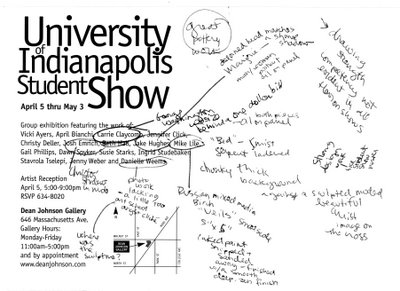
The scribbling on the postcard above are my notes for the critique below. That's how I write critiques - on whatever scrap piece of paper I have handy. I just usually need to write a key word to bring an image I viewed to life in my mind.
The gallery renews itself with refreshing new work by 16 students that smoothly knock most of the recycled, Herron-looking work at various Herron senior shows out of new art contention. Exceptions were the sculpture and photography, which were just a tad on the art school angst side. The show’s strengths are most evident in strong basic drawing competency and fluid graphic design as demonstrated in the student show poster. Josh Emrich offers technical and expressive maturity in his large-scale figurative painting while Carrie Claycomb's nearly life-size George Washington and Crucifixion paintings exhibit color and in-your-face composition confidence. A chunky, thick paint background frames a softly sculpted, molded image of Christ. Other paintings by Jake Hughes and Mike Lile serve as notable examples of real talent and visual refinement not always seen in local student shows. It is unfortunate that the opening reception had so few attendees when the work as this excellent. Through May 3, 2002; 317-634-8020, www.deanjohnson.com. -Mary Lee Pappas
Wednesday, April 10, 2002
“Symphony in Color, A Young People’s Art Contest” – Indianapolis Museum of Art – April 10, 2002 – 3 1/2 stars
This 50-year-old annual staple in art competitions explores children's musical experiences through the visual arts. One hundred works created by first through sixth-graders while listening to classical standards, such as Debussy's "La Mer," "Dialogue du vent et de la mer," were selected for exhibit in the Clowes Galleries. The crayon and pastel art pieces created under the influence of Scriabin's Symphony No. 2 Opus 29 are full of delightful pink energy and imaginative floating instruments reflecting the young listeners' unadulterated experiences of the music. Organized by the Junior Group of the Women's committee of the Indianapolis Symphony Orchestra, this is one of two wonderful examples of the value of arts education. Through April 25, 2002; 317-923-1331. – Mary Lee Pappas
“Learning to See: The Art of Art Education” – Herron Gallery - April 10, 2002 – 4 stars
The Herron Gallery scores with this show. Twelve Herron alumni, currently K-12 art educators in Central Indiana, executed their ingenious and intriguing classroom lesson plans inspired by art history, music and art processes. They incorporate all visual art forms in the gallery, creating a very interactive, friendly and informative experience. A Jasper Johns flag lesson plan by Lisa Cooreman, St. Richard's School, meshes individual student created flag pieces (constructed with the likes of Popsicle sticks and other craft closet goodies) into a single large-scale sculptural piece that holds its own in the gallery as well as anything shown here at any time. Mindy Jared's Pike High School students' handmade books are all unbelievably well-crafted; each is also a carefully, thoughtfully executed piece of art. Museum programmers and art teachers take note: A CD-Rom of the featured lesson plans are available for free in the gallery. Through April 13, 2002; 317-920-242). – Mary Lee Pappas
Kwang Cha Brown - CCA Gallery – April 10, 2002 – 4 stars

Three pieces by this Herron painting BFA, Indiana State University MFA and Pont-Aven School of Art attendee are masterful impressionistic paintings rich with the lush, deep tones of caked oil paint one would expect to see on museum walls, particularly when juxtaposed against most CCA sterile standards. Brush strokes look intentionally inspired, as if she is painting history or painting from her past life. One landscape's amber yellow grassy foreground, with its specific speckled strokes, sinks into its green grassy background. Visual appearances of atmosphere and light are brilliantly interpreted. Through May 31, 2002; 317-255-9633. -Mary Lee Pappas
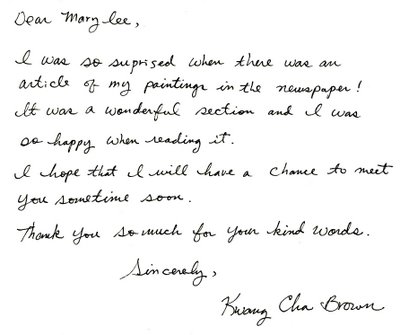
Wednesday, March 06, 2002
Art stalwarts closing - March 6 - 13, 2002
Art stalwarts closing
NUVO Newsweekly, March 6 - 13, 2002
Page 8
CCA Gallery, Alliance Rental Gallery, Indianapolis Museum of Art, Paul Sweeney, Hoosier Salon, Watercolor Society, John Robert Dickhaus
Wednesday, February 27, 2002
“White Light” Joy Jackson – Harrison Center for the Arts – Feb. 27, 2002 – 3 1/2 stars
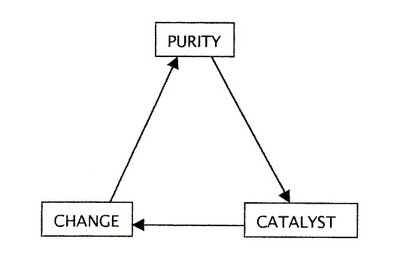
No relation (or inspiration) to the Herron show of last September by the same name, its examination of white light is less precise and simplified into a metaphor for purity as a catalyst for change. Jackson, who teaches glass blowing at the Indianapolis Art Center, having received her MFA in the subject at Temple University in Philadelphia, presents 20 clear, milky and white glass vases sitting upon suspended wire and perfecting eye-level glass shelving cutting across one of the gallery's corners. Jackson, an installation artist of talent, transforms the gallery space into her unique environment moreso than any other paintings-perfectly-centered-on-the-wall exhibit in this space has even come close to with lighting and installation, tic tac mask sculptures and glassware. A 2,000-pound Morton salt block installation is ghostly unnatural with its electric blue-tinged white light emitting from the crevices of the manufactured salt bricks. Under ownership of Redeemer Presbyterian Church the Harrison Gallery is improved with this exhibit as its proof, Through April 7, 2002; 317-514-6787. – Mary Lee Pappas
“Enchanted Bloom” Andrea Eberbach and Riccardo Consciasecca – Hilbert Conservatory, White River Gardens – Feb. 27, 2002 – 3 stars
Illustrator Eberbach finally frames her beautiful pastels appropriately (big white mats in black frames instead of decorated foam board), giving them a proper presentation they deserve. Her pastel handling is soft, perfectly melting the warm, rich colors with the same weight of hand, creating an even and gentle rendering of what might otherwise be a flat image. Eberbach's illustrations are unmistakably hers both for technique and her keen compositional knack. Consciasecca's super close-up digital image photos are sharp and force you to stop and smell the flowers if you never have before. Snapping super zooms of blossoms isn't anything new by any means - a flower at such a magnifying glass perspective is hard to get wrong as the flower abstracts and speaks for itself, but these are well-presented with the digital image allowing for a crisper, cleaner image. Through March 3, 2002; 317-630-2001. -Mary Lee Pappas
Wednesday, February 20, 2002
“A Hobby Handed Down” Elizabeth Young – College Ave. Library – Feb. 20, 2002 – 2 1/2 stars
Numbered handmade quilts, most folded over so they don't hang over into shelves and walkways, line library walls in their mostly very contemporary colors and fabrics. Some older quilt pieces incorporating floor sacks rescued and refiniggled enforce the sweet utility and family feel of this technically everyday ensemble. All of the quilts carry a family story or significance (each explained by Young in a little photoalbum scrapbook), having all been created for use over art, lending this exhibit its true charm. The fabrics and combinations in which they are teamed into patterns are not always aesthetically pleasing, but this is easily discounted when seen as real women's work. Through Feb. 28, 2002; 317-269-1732. – Mary Lee Pappas
Brian L. Phillips - Barnes & Noble – Feb. 20, 2002 – 2 1/2 stars
Phillip's business cards tout "self taught artist," a truth made most evident by the uncomfortable, unmixed handling of the oil paints. The black-outlined, geometric, generic painted portrait heads with dinner plate eyes softly twist into distinct multidimensional, primary-colored, flat-component puzzle piece fragments. Egon Schiele's elementary school doodlings may have resembled this work. Phillips' artistic strength lies in the fluid and tight compositions that feature the broken down angularity of these idealized, abstracted and gaunt faces. Compositional strength would benefit from mixing, layering and playing a bit more with the paint. Through February, 2002; 317-634-2515. - Mary Lee Pappas
Subscribe to:
Posts (Atom)








